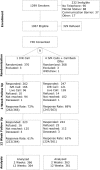An interactive voice response system to continue a hospital-based smoking cessation intervention after discharge
- PMID: 21330278
- PMCID: PMC3107613
- DOI: 10.1093/ntr/ntq248
An interactive voice response system to continue a hospital-based smoking cessation intervention after discharge
Abstract
Introduction: Hospitalized smokers benefit from tobacco counseling received in hospital only if it continues after discharge. Interactive voice response (IVR) technology may be useful in delivering this care.
Methods: We conducted a randomized controlled trial testing two intensities of follow-up contact using an IVR system; 738 cigarette smokers who received inpatient counseling at an academic medical center were enrolled. Participants were randomized to receive four IVR calls during the first month postdischarge that included the offer of a call back (CB) from a smoking counselor (IVR + CB, N = 368) or 1 IVR call at 2 weeks postdischarge that assessed smoking outcomes without offering any counseling support (IVR, N = 370). All were assessed by human telephone call at 12 weeks. Postdischarge counseling and medication utilization rates and self-reported smoking cessation were assessed at 2 and 12 weeks postdischarge.
Results: Of those randomized to IVR + CB, 59% received a CB offer and 34% of those receiving offers accepted. Cessation rates did not differ between IVR + CB and IVR at 2 weeks (39% vs. 39%, rate ratio: 1.02, 95% CI: 0.85-1.22) or 12 weeks (29% vs. 26%, rate ratio: 1.11, 95% CI: 0.90-1.41). Medication use did not differ by group but was higher among those accepting versus declining CB offers (69% vs. 52%, p < .05).
Conclusions: An IVR system is feasible for postdischarge follow-up and support for hospitalized smokers. Participants, especially pharmacotherapy users, took advantage of postdischarge counseling offers, although offers were not associated with increased smoking cessation.
Figures
References
-
- Forster AJ, Boyle L, Shojania KG, Feasby TE, van Walraven C. Identifying patients with post-discharge care problems using an interactive voice response system. Journal of General Internal Medicine. 2009;24:520–525. Retrieved from http://www.ncbi.nlm.nih.gov/pmc/articles/PMC2659152/ - PMC - PubMed
-
- Forster AJ, van Walraven C. Using an interactive voice response system to improve patient safety following hospital discharge. Journal of Evaluation in Clinical Practice. 2007;13:346–351. doi: 10.1111/j.1365-2753.2006.00702.x. - PubMed
-
- The Joint Commission. Improving America's Hospitals: The Joint Commission's Report on Quality and Safety 2008. 2008 Retrieved from http://www.jointcommissionreport.org/pdf/JC_2008_Annual_Report-updated.pdf.
-
- Miller NH, Smith PM, DeBusk RF, Sobel DS, Taylor CB. Smoking cessation in hospitalized patients: results of a randomized trial. Archives of Internal Medicine. 1997;157:409–415. doi:10.1001/archinte.157.4.409. - PubMed
-
- Oake N, Jennings A, van Walraven C, Forster AJ. Interactive voice response systems for improving delivery of ambulatory care. American Journal of Managed Care. 2009;15:383–391. Retrieved from http://www.ajmc.com/issue/managed-care/2009/2009-06-vol15-n6/AJMC_09Jun_.... - PubMed
Publication types
MeSH terms
Grants and funding
LinkOut - more resources
Full Text Sources
Medical
Miscellaneous


